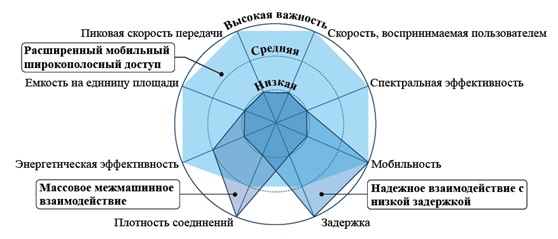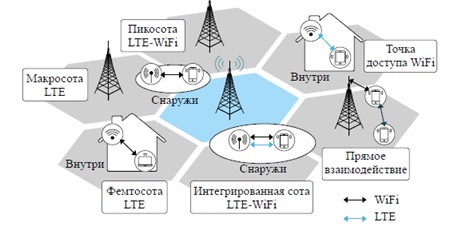Infocommunication technologies and communication systems
Currently, the development of telecommunication technologies is proceeding at a rapid pace, and it follows from this that the demand for wireless network resources is also increasing. But the radio resource is not unlimited, and for its optimal use, new specifications are developed that determine the operation of promising wireless communication networks, and existing methods for accessing them are optimized. Due to the evolution, the various radio access technologies that make up heterogeneous wireless networks are significantly fragmented and insufficiently integrated with each other. This restrains their further development, and also creates a gap between the requirements of user applications and the effective functioning of modern mobile access systems.
Due to the evolution, the various radio access technologies that make up heterogeneous wireless networks are significantly fragmented and insufficiently integrated with each other. This restrains their further development, and also creates a gap between the requirements of user applications and the efficient functioning of modern mobile access systems.
In addition to classical telephony, modern mobile access networks provide users with the possibility of transmitting heterogeneous traffic, and in the future they will provide support for Internet of things, cloud computing and software-defined networks. Such heterogeneous wireless networks closely integrate with each other all existing as well as promising radio access technologies, as a result of which there is a need to solve emerging scientific and technical problems.
To improve the quality of service in 5G systems, a coordinated interaction of cellular radio access technologies, such as the LTE system, with the WiFi local access technology family will be required. In addition, it seems promising to use direct connections between user devices to reduce the load on the infrastructure of communication channels [ 5 ].
Communication networks fifth generation
, the so-called 5G, coupled with Big Data Analysis and the Internet of Things (IoT), are designed to become one of the foundations of the digital economy, the main driving force of which should be artificial intelligence (AI). For more than 40 years, four generations of mobile networks have changed. If first-generation 1G cellular networks have long disappeared, then 2G, 3G and 4G networks are still in operation. Moreover, a certain amount of legacy 3G and 4G network infrastructure will organically be part of the fifth generation 5G mobile networks.
5GPPP – (5G Infrastructure Public Private Partnership) is considered one of the leading 5G standardization partnerships. The organization sets ambitious goals for developing requirements for the 5G network, for example, capturing the network capacity by 1000 times, reducing the power consumption of user devices by 90%, significantly reducing the time it takes to create new services and services, complete and safe network coverage and with a negligible data transfer delay, et al. [3–4].
5G networks greatly expand the limited functionality of previous generation mobile networks. The main functional features of 5G networks are as follows:
5G networks can significantly increase the speed of data transmission through various radio access technologies (RAT), and by using the new 5G NR radio frequency spectra (New Radio). The user receives almost unlimited bandwidth, both for home use of various services, and for the purposes of enterprises (Immersive Telepresence, Industrial IoT, etc.)
The aim of the study is to increase the efficiency of the organization of resource sharing models for heterogeneous high-density wireless networks.
The main objectives of the study:
Object of study : Communication networks fifth generation
Research Subject : Collective Use of the Resource for High Density Heterogeneous Wireless Networks.
The development of fourth-generation 4G mobile broadband mobile technologies was completed in 2011, and as it became widely implemented in practice, it became necessary to design and develop fifth-generation 5G mobile networks.
For end users, you can define the following requirements for a new generation of networks:
Along with network capacity and connection speed, an important factor is the uniformity of network coverage, affecting the quality of service and the perception of services by the user. The reliability of the cellular coverage of modern indoor networks remains unsatisfactory, and promising 5G systems are aimed at ensuring a uniform and seamless connection. Another important aspect is that cellular systems in the licensed spectrum are often combined with networks operating on unlicensed frequencies (WiFi).At the same time, modern subscriber terminals have the ability to use several technologies of radio access at a time, which will allow unloading cellular networks by directly connecting devices in an unlicensed spectrum.
According to forecasts, the volume of mobile traffic transmitted over wireless communication networks will increase significantly over the next years. As a result, the currently existing broadband access networks will be subject to significant congestion from – due to insufficient radio network capacity, which will lead to a sharp decrease in the quality of service.Unloading the network will be possible using direct connection of subscriber devices. Neighboring terminals can interact and exchange data directly, without involving network infrastructure, which will significantly increase the capacity of communication systems with an increase in the number of devices involved [3].
The main incentives for increasing the amount of user data transmitted through communication networks are the high popularity of multimedia applications, a wide variety of subscriber terminal models, as well as a wide variety resource-intensive applications and services. It is expected that the load on mobile communication systems will increase 10 - 100 times until 2030, and existing 4G networks may not be able to cope with it. As a result, improving the efficiency of using the wireless spectrum already available to systems may not be enough to achieve the required performance. In this regard, it seems important both the appointment of new radio frequencies for exclusive use by wireless access networks, and a more efficient use of public frequencies for the needs of mobile operators. The three main solutions to increase network capacity are radical network densification, massive MIMO systems, and microwave communications [ 10 ].

Figure 1 – The main ways to increase the capacity of 5G systems
(animation speed – 7 number of frames – 6)
Given the variety of requirements imposed by many applications, the basic principle of the development of the 5G system is versatility and flexibility in servicing users of various types. In addition, restrictions related to the power consumption of devices and the efficient use of spectral resources should be taken into account. The 5G system, having a wide range of declared capabilities, can change the values ??of individual key parameters depending on the conditions of a particular application.
For the three introduced classes of 5G scenarios, the figure shows the expected level of their importance and conditional gradation by categories of high, medium and low significance.

Figure 2 – Key Features of 5G Technology Scenarios
In mobile broadband scenarios, the most important are the user-perceptible data transfer rate, mobility, and ensuring high energy and spectral efficiency.
In scenarios involving the reliable interaction of devices with low latency, the speed of information delivery becomes of paramount importance, for example, to ensure the operation of critical applications. Massive machine-to-machine scenarios require a high density of connected devices due to their very large number.
During the subsequent development of 5G heterogeneous networks, additional requirements may arise aimed at ensuring their more flexible, reliable and secure functioning when organizing all kinds of applications and services that will arise in the future.
As noted above, restrictions on the capacity and quality of connections in mobile networks compared to the requirements of 5G necessitate a closer integration of cellular and local access networks. Figure 3 schematically shows the modern heterogeneous network of the HetNet cellular operator. The HetNet system includes a hierarchical structure of cells of various sizes, including macro cells to provide seamless coverage, basic access and mobility, as well as various small cells (pico cells, femtocells, WiFi access points, combined LTE & WiFi modules, etc.). Corresponding access equipment has lower transmission power and cost, allowing you to increase the capacity of the system by reducing the distance between the network infrastructure and the subscriber in areas with a high demand for service.

Figure 3 – Key Features of 5G Technology Scenarios
Promising 5G technologies can offer a set of important improvements, primarily aimed at increasing the capacity of a communication system, which includes: